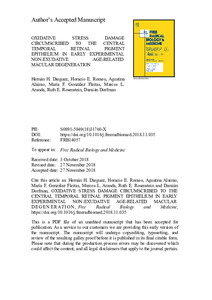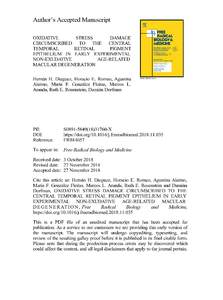Please use this identifier to cite or link to this item:
https://repositorio.uca.edu.ar/handle/123456789/9159| Título: | Oxidative stress damage circumscribed to the central temporal retinal pigment epithelium in early experimental non-exudative age-related macular degeneration | Autor: | Dieguez, Hernán H. Romeo, Horacio Alaimo, Agustina González Fleitas, María F. Aranda, Marcos L. Rosenstein, Ruth E. Dorfman, Damián |
Palabras clave: | CEGUERA; ANTIOXIDANTES; MITOCONDRIA; DEGENERACION MACULAR; ESTRES OXIDATIVO; GANGLIOS; ENVEJECIMIENTO | Fecha de publicación: | 2019 | Editorial: | Elsevier | Cita: | Dieguez, H.H. et al. Oxidative stress damage circumscribed to the central temporal retinal pigment epithelium in early experimental non-exudative age-related macular degeneration [en línea]. Free Radical Biology and Medicine. 2019, 131. ISSN 0891-5849. doi:10.1016/j.freeradbiomed.2018.11.035 Disponible en: https://repositorio.uca.edu.ar/handle/123456789/9159 | Resumen: | Abstract: Non-exudative age-related macular degeneration (NE-AMD) represents the leading cause of blindness in the elderly. The macular retinal pigment epithelium (RPE) lies in a high oxidative environment because its high metabolic demand, mitochondria concentration, reactive oxygen species levels, and macular blood flow. It has been suggested that oxidative stress-induced damage to the RPE plays a key role in NE-AMD pathogenesis. The fact that the disease limits to the macular region raises the question as to why this area is particularly susceptible. We have developed a NE-AMD model induced by superior cervical ganglionectomy (SCGx) in C57BL/6J mice, which reproduces the disease hallmarks exclusively circumscribed to the temporal region of the RPE/outer retina. The aim of this work was analyzing RPE regional differences that could explain AMD localized susceptibility. Lower melanin content, thicker basal infoldings, higher mitochondrial mass, and higher levels of antioxidant enzymes, were found in the temporal RPE compared with the nasal region. Moreover, SCGx induced a decrease in the antioxidant system, and in mitochondria mass, as well as an increase in mitochondria superoxide, lipid peroxidation products, nuclear Nrf2 and heme oxygenase-1 levels, and in the occurrence of damaged mitochondria exclusively at the temporal RPE. These findings suggest that despite the well-known differences between the human and mouse retina, it might not be NE-AMD pathophysiology which conditions the localization of the disease, but the macular RPE histologic and metabolic specific attributes that make it more susceptible to choroid alterations leading initially to a localized RPE dysfunction/damage, and secondarily to macular degeneration. | URI: | https://repositorio.uca.edu.ar/handle/123456789/9159 | ISSN: | 0891-5849 | Disciplina: | MEDICINA | DOI: | 10.1016/j.freeradbiomed.2018.11.035 | Derechos: | Acceso abierto. 12 meses de embargo | Fuente: | Free Radical Biology and Medicine. 2019, 131 |
| Appears in Collections: | Artículos |
Files in This Item:
| File | Description | Size | Format | |
|---|---|---|---|---|
| oxidative-stress-damage-romeo.pdf | Texto completo disponible el 02/12/2020 | 1,93 MB | Adobe PDF |  View/Open |
| oxidative-stress-damage-romeo.jpg | 706,29 kB | JPEG |  View/Open |
This item is licensed under a Creative Commons License

